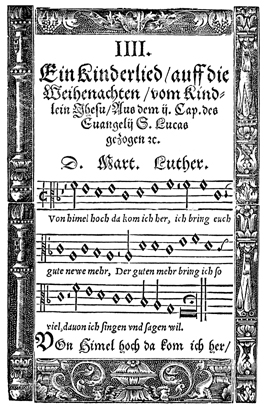J. S. Bach, Canonic Variations: Vom Himmel hoch

If you are in Germany this Christmas, you will have many opportunities to hear the popular Christmas hymn Vom Himmel hoch, da komm’ ich her (From Heaven Above to Earth I Come). Martin Luther composed the hymn in 1534, adapting the secular tune Aus fremden Landen komm ich her (I Come from Foreign Lands). If you don’t know the chorale tune, you might want to hear it first in its unembellished form.
The tune has formed the basis of numerous compositions over the centuries. One such composition is J. S. Bach’s organ work Die Canonischen Veränderungen über ein Weihnachtslied (The Canonical Variations on a Christmas Song), BWV 769. A canon (literally, a rule) usually denotes a work of music in which one voice imitates another in a strict fashion with the voices most often entering sequentially, as in Row, Row, Row Your Boat. Bach, being the master of counterpoint that he was, produced some of the most amazing canons for their mathematical complexity, precision, and musicality.
A copper engraving of the work exists from 1747 when Bach joined the music theory society formed by his student, the polymath Lorenz Christoph Mizler. Bach’s Canonic Variations satisfied the society’s requirement for membership. Other members included Handel and Telemann.
There is also an autograph manuscript (designated BWV 769a) that presents the five variations in a different order. BWV 769 has the most complex variation in the middle (as number 3) while BWV 769a places that variation last. This performance follows the scheme of BWV 769.
The first canon is relatively easy to follow. The sixteenth-note figure in the top line is repeated literally in the middle voice one octave lower and one beat later (in 12/8 time). The chorale tune appears in long notes played on the pedals. This organist uses a registration that allows the chorale tune to stand out. The second variation follows a similar pattern, but the canon is at the interval of a fifth (not at the octave) and so the imitation may be a bit harder to follow.
The third variation presents several different canons, beginning with a canon at the sixth, then at the third, then at the second, and finally at the ninth. Adding to the complexity, the imitative voice is inverted, meaning it is the mirror image of the original (when the original goes up, the imitating voice goes down). The imitation throughout this variation is in the chorale tune itself, not the accompanying line in the pedal, so that makes the canons somewhat easier to hear.
Rather than dissecting all of the canons, those who are interested can follow the score here (keep in mind the different ordering of the variations). You may also find the short interview with the organist interesting (with English subtitles).



